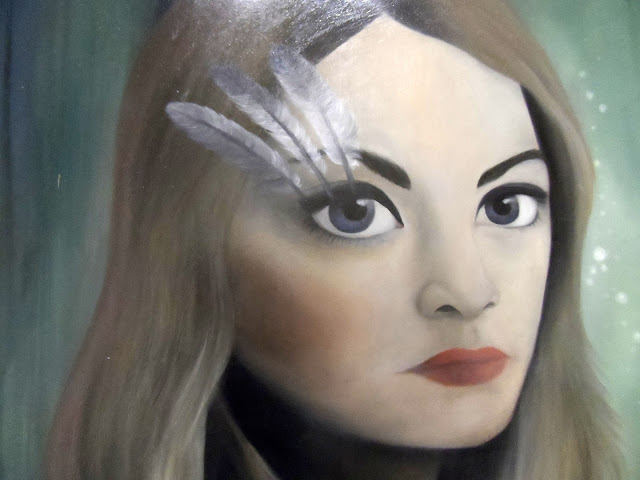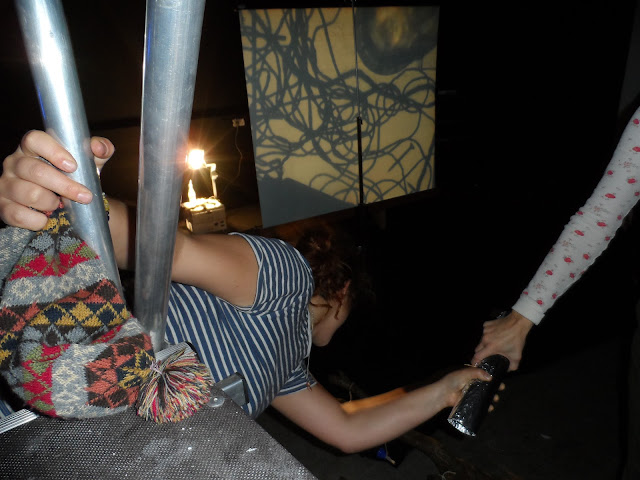Earlier
this month I visited ‘Frieze’ the international contemporary art fair which takes
place for a few days in October in
London’s Regent’s Park, organised by the publishers of Frieze Art Magazine.
The piece
of work that really captured my attention was a piece by Tracey Emin, ‘Head Falling’, a 6.17 x 63.78 inch piece
of embroidered calico. From a distance it looked like a sketch of a headless woman
in black ink, slapped on with rough quick brush strokes, with areas of thick
and thin paint, which in itself was interesting to look at. The energy that the
piece emanated was enough to persuade me to have a closer look, which revealed
the truth that it was in fact it not painted but embroidered on, making it all
the more interesting. Emin managed to epitomize the activity of paint with the
slow process of embroidery so effectively and so masterfully replicated that
energy. I love the way the viewer is ‘deceived’, or perhaps that’s too negative
a viewpoint, I’ll focus on the enlightenment
they receive when they step closer to the work and discover the truth.
The piece
was part of the Lehmann Maupin Gallery, Booth F12, with other works from the
gallery exhibited such as Juergen Teller’s photograph ‘Cerith, Suffolk’ and Teresita Fernandez’ ‘Golden’ (30 Dissolves) made from brass. The booth itself was
a little bit disappointing, unlike some gallery booths at the at fair
which were evidently contending to win
‘Best Booth’, it was clear that the
Lehmann Maupin gallery wasn’t as concerned with that, compared to the
unique Pilar Corrias’s pink carpeted
booth for instance. I suppose they were hoping that the work would speak for
themselves without the need for exciting carpeting or wallpaper. While there is
no denying that the pieces were all interesting to look at, one would think in
an event as huge as Frieze that the curators would aim to make what they have
to offer as memorable as possible.
 |
| Lehmann Maupin Gallery, Booth F12 |
However it was Emin’s piece that really inspired me, having
pre-frieze been exhibited as part of this year’s Turner Contemporary in Margate,
Emin’s hometown. The place which she grew up in and provided inspiration for many of her most
famous art works; the exhibition ‘She Lay Down Deep Beneath The Sea’ was described by Waldermar Januszczak from The Sunday Times as being “the most beautiful I have seen by
her;” a sensitive installation across three galleries, exploring the themes of
love, sensuality and romanticism. It featured both new and old work
including drawings, monoprints, sculptures and neons and was described as
giving “maximum force” by the Financial Times’ Jackie Wullschlager. Holding the
exhibition in Margate meant a lot to Emin, “I still can't really believe that
I'm showing in Margate. Even in my wildest dreams I could never believe there
would be a gallery like the Turner Contemporary there.” She hopes it will make
a difference to the community also; bringing credited contemporary art to the
sea side town will draw in tourism and she hopes will enlighten the local
residents to contemporary art, particularly a style like hers which isn’t
always popular with everyone, “the brilliant thing about Margate is that it's
one hour from London on the train so I'm hoping lots of people will come and
visit not just my show but the beautiful sunsets and sandy beaches.'
 |
| She Lay Down Deep Beneath The Sea at the Turner Contemporary |
The exhibition
has received so much acclaim because of Emin’s new oeuvre, as they are calling it, her change of direction. No longer
is it a man bashing, hate parade, but she’s talking about love. Of course she
said she’s a long way off from being healed, but the new tone of work suggests
a ‘new’ Emin. I find it quite affecting how her personal journey is documented
throughout her relationship with herself, men and love.
Feminist
art work is becoming more and more essential to me in discovering what I want
my work to be about. The unequivocal attitudes on morality and womanhood are so
inspiring and relevant to what I am hoping to do within my own practise. How women are scrutinized and
treated and the assumptions and expectations that are made are all key aspects
to my current ideas. Although this seems a crude association, but since I was
originally interested in exploring the sexualisation of girls, a woman like
Emin knows too well what it is like to fall victim to the male brutality and
being an artist she has been able to represent and disseminate that anger and
pain through her work. Her own devastating experiences have obviously
influenced her and even though she says she is far off from being healed, she
is overcoming her trauma and is now turning it around in a more sensitive and
accessible way. People will be able to relate to this new work better I think,
as opposed to the bluntness of ‘My Bed,’ for instance. While people do want
to be voyeurs to things that appal them; with our natural curiosity, true
appreciation will come if the viewer feels moved
by the work. The embroidery on these pieces reveals a tenderness and honesty
that surmounts in all her work but in Head
Falling it is particularly poignant, to me at least.










































































